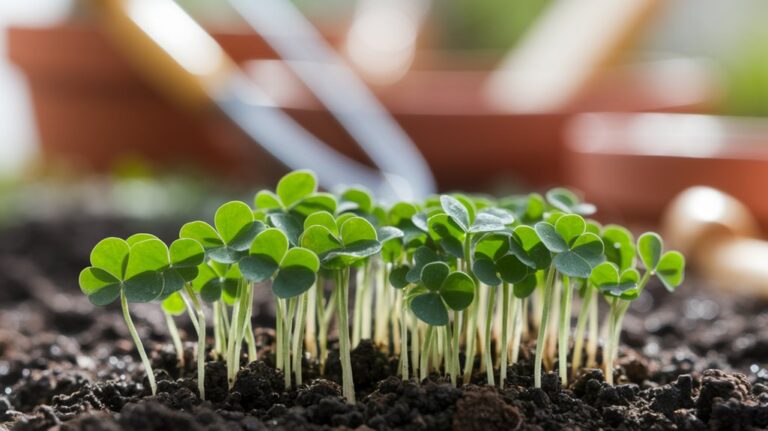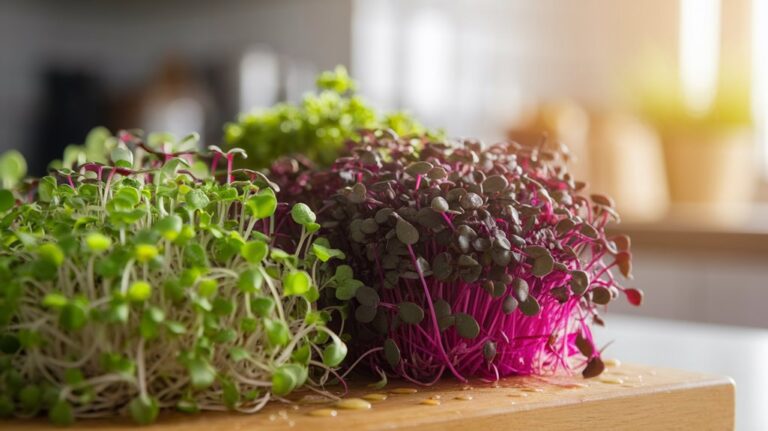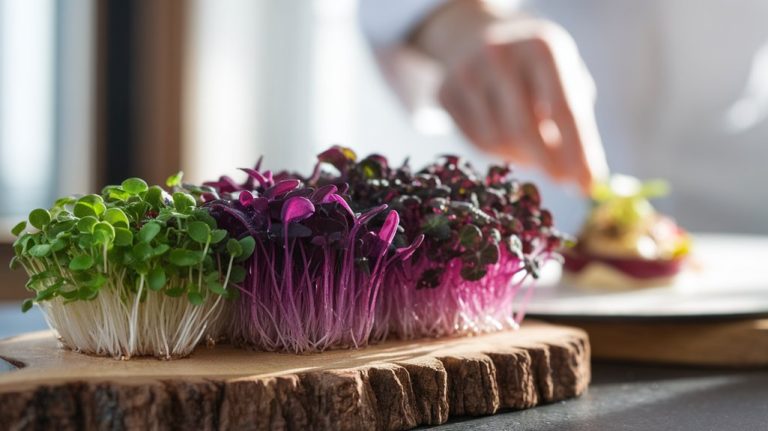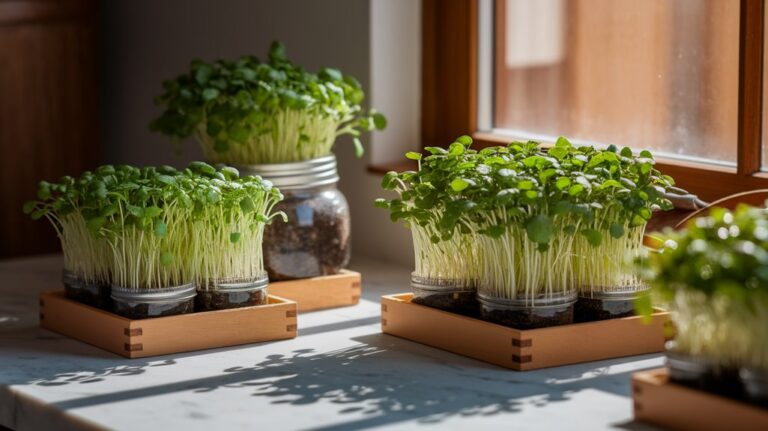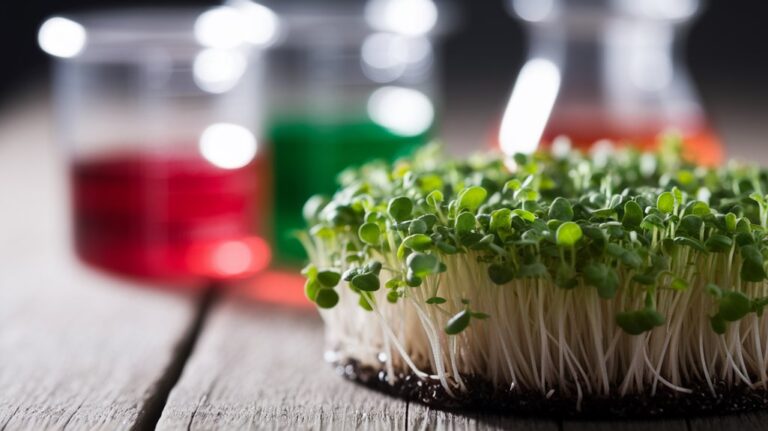Organic Microgreens: Growing Healthy Without Chemicals
Growing organic microgreens is a rewarding way to cultivate nutrient-rich plants without harmful chemicals. I’ve found that these tiny greens, harvested shortly after germination, pack a powerful punch of vitamins and antioxidants. By choosing high-quality organic seeds and using nutrient-rich soil, I can create a clean, healthy food source right at home. Plus, the process is simple and sustainable, contributing to environmental health. So, let’s explore how you can start your own organic microgreen garden today.
Key Takeaways
- Organic microgreens are grown without synthetic pesticides or fertilizers, ensuring a chemical-free harvest.
- They are cultivated in nutrient-rich soil, promoting healthy growth and superior nutritional value.
- Microgreens require minimal water and space, making them ideal for sustainable urban farming.
- Higher concentrations of vitamins and antioxidants in microgreens enhance health benefits compared to mature plants.
- Following proper care practices ensures optimal growth and flavor, maintaining a healthy growing environment.
What Are Organic Microgreens?
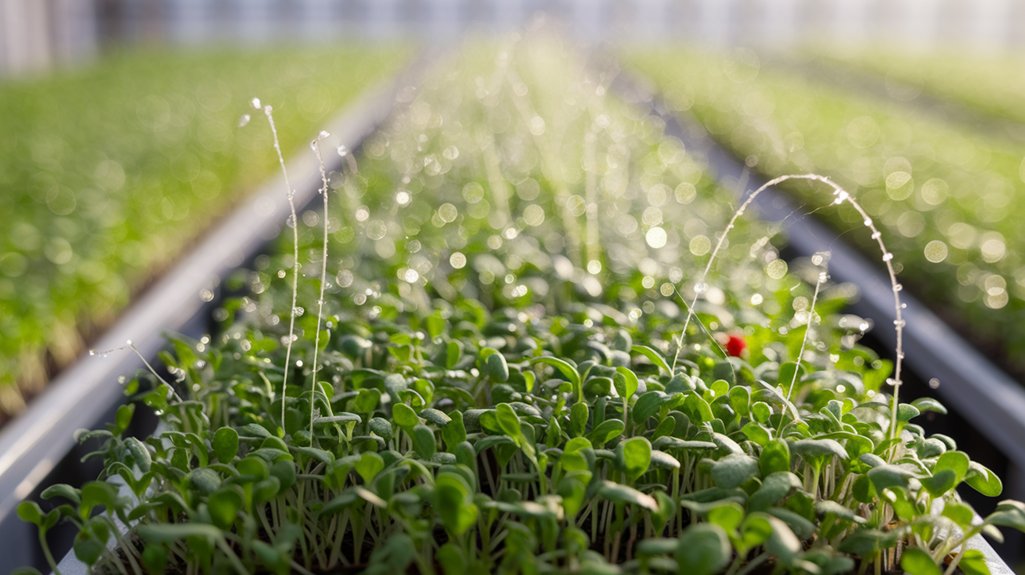
Organic microgreens are young, edible plants harvested just after the first true leaves have developed, typically within 7 to 21 days of germination.
These tiny greens come from various species, including herbs and vegetables, and are grown in nutrient-rich soil without synthetic pesticides or fertilizers. The growth process relies on optimal light, temperature, and moisture, which I find fascinating.
Their small size doesn’t diminish their nutrient density; in fact, research shows that microgreens often contain higher concentrations of vitamins and antioxidants compared to their mature counterparts.
This makes them not just a culinary delight, but also a subject of interest for health-conscious individuals. Understanding their growth cycle and nutritional profile is key for anyone considering incorporating these greens into their diet.
Benefits of Growing Organic Microgreens
Growing organic microgreens offers significant nutritional advantages, often packing more vitamins and minerals than their mature counterparts.
Additionally, cultivating these plants contributes to environmental sustainability by promoting local food production and reducing carbon footprints.
I’m excited to explore how these benefits can enhance both personal health and ecological well-being.
Nutritional Value Boost
While many people may overlook them, microgreens offer a remarkable nutritional boost that can significantly enhance our diets. Research shows these tiny greens pack a concentrated punch of vitamins and minerals, often containing higher levels than their mature counterparts.
For instance, studies indicate that microgreens like broccoli and radish can have up to 40 times more nutrients than the fully grown plants. This makes them an excellent choice for nutrient-dense meals.
Additionally, their high levels of antioxidants help combat oxidative stress, promoting overall well-being. By incorporating organic microgreens into my meals, I not only elevate the flavor but also enrich my nutritional intake, making it easier to achieve a balanced diet without relying on synthetic additives.
Environmental Sustainability Impact
Microgreens represent a sustainable agricultural practice that significantly reduces environmental impact. By requiring less water and space than traditional crops, they allow for efficient resource use.
Studies show that microgreens can be cultivated in urban settings, minimizing transportation emissions associated with food distribution. Furthermore, growing them organically eliminates harmful chemical inputs, preserving soil health and promoting biodiversity.
These small plants also sequester carbon, contributing to climate change mitigation. With their short growth cycle, microgreens offer rapid yields, enabling farmers to adapt quickly to market demands while reducing waste.
In my experience, integrating microgreens into sustainable farming practices not only benefits the environment but also fosters a connection to the food we consume, promoting a healthier ecosystem overall.
Choosing the Right Seeds for Microgreens
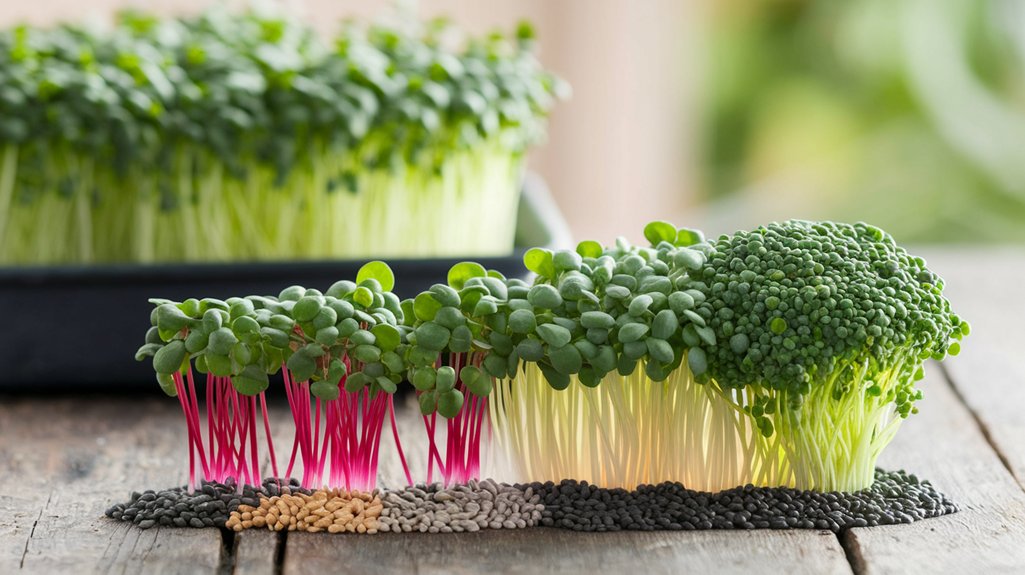
Selecting the right seeds for microgreens is crucial, as it directly impacts both the flavor and nutritional value of your harvest. I’ve found that specific varieties perform better than others when it comes to growth rates and taste. Here’s a quick reference table that might help you decide:
| Seed Type | Flavor Profile | Nutritional Benefits |
|---|---|---|
| Radish | Spicy and peppery | High in vitamins A, C, E |
| Broccoli | Mild and nutty | Rich in sulforaphane |
| Pea Shoots | Sweet and crisp | Excellent source of protein |
| Sunflower | Nutty and earthy | Packed with healthy fats |
When choosing seeds, consider your taste preferences and the specific health benefits you want to gain from your microgreens.
Essential Supplies for Growing Microgreens
A successful microgreens garden hinges on having the right supplies at your disposal.
First, I recommend using shallow trays with drainage holes to prevent waterlogging. Opt for a high-quality organic potting mix, as it provides essential nutrients and promotes healthy growth.
You’ll also need a light source; fluorescent or LED grow lights are ideal for ensuring your microgreens receive adequate light, especially in low-light conditions.
A spray bottle for gentle watering helps maintain moisture without disturbing the delicate seedlings. For efficient seed distribution, consider using a seed spreader.
Lastly, keeping a humidity dome can create a greenhouse effect, optimizing germination rates. Each of these supplies plays a critical role in cultivating robust, chemical-free microgreens.
Step-by-Step Guide to Growing Microgreens
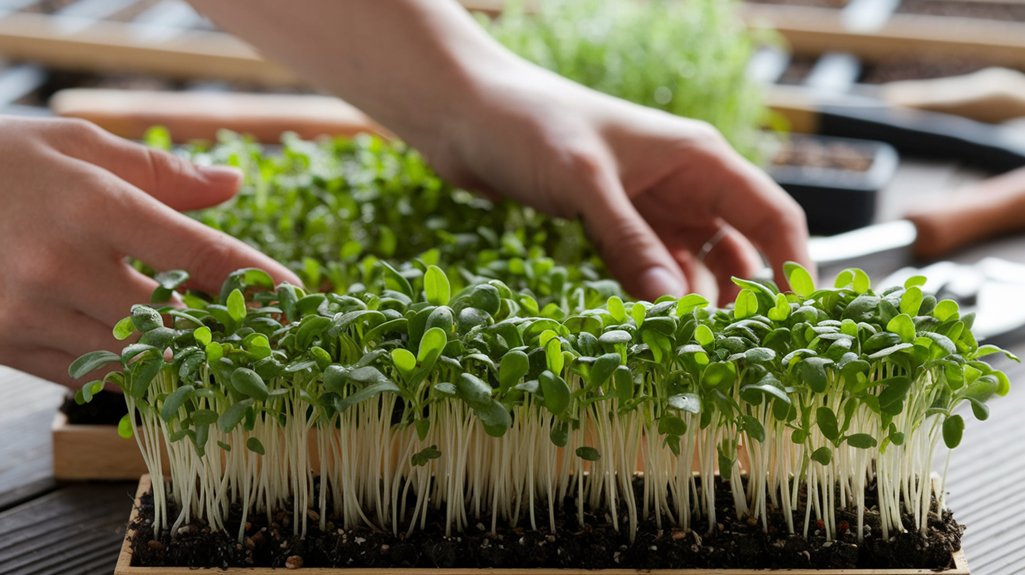
Growing microgreens can be broken down into five essential steps that ensure success from seed to harvest.
| Step | Description |
|---|---|
| Choosing Seeds | Select high-quality, organic seeds. |
| Soaking | Soak seeds for 4-8 hours to enhance germination. |
| Planting | Spread seeds evenly on moist soil. |
| Watering | Mist daily to keep soil consistently damp. |
Caring for Your Microgreens
Caring for microgreens is crucial to their development and overall health. I ensure they receive adequate light, ideally 12 to 16 hours daily, to promote robust growth.
Monitoring moisture levels is essential; I keep the soil consistently damp but never soggy, as excess water can lead to mold or root rot. I also make it a point to ventilate the growing area to prevent fungal issues.
Fertilization isn’t typically necessary, but I occasionally use diluted organic nutrients if the growth appears stunted. I pay attention to temperature, keeping it between 65°F and 75°F for optimal germination and growth.
Harvesting and Storing Microgreens
Once microgreens reach the appropriate height, it’s time to harvest them for optimal flavor and nutrition. I usually wait until they’re about 1 to 3 inches tall, which is when their flavors are most pronounced.
To harvest, I employ clean, sharp scissors, cutting just above the soil line to minimize damage. This technique preserves the delicate stems and leaves, ensuring maximum taste.
After harvesting, I carefully rinse the microgreens under cool water to remove any debris. I then pat them dry with a paper towel to prevent excess moisture, which can lead to spoilage.
For storage, I place them in a breathable container lined with a damp paper towel and refrigerate them. This method keeps them fresh for up to a week, maintaining their vibrant flavor and nutritional value.
Creative Ways to Use Microgreens in Your Cooking
When I incorporate microgreens into my cooking, I find they enhance salads with their vibrant flavors and textures.
These tiny greens also serve as elegant garnishes, elevating the presentation of dishes.
Understanding their culinary potential can significantly transform both everyday meals and special occasions.
Flavorful Salad Enhancements
Microgreens can elevate salads in ways that often surprise even the most seasoned cooks. These tiny greens pack a punch in flavor and nutrition, making them an ideal addition to any salad.
For instance, I often use pea shoots for a sweet, crisp texture, while arugula microgreens add a peppery kick. Research shows that these young greens are nutrient-dense, offering higher concentrations of vitamins compared to their mature counterparts.
I also enjoy mixing microgreens into dressings; blending them with olive oil and vinegar creates a vibrant, flavorful base.
Garnishes for Elegant Dishes
How can something so small transform a dish into a work of art? Microgreens, with their vibrant colors and delicate textures, serve as the perfect garnish for elegant dishes.
Studies show that they not only enhance visual appeal but also pack a concentrated flavor profile and nutritional benefits. For instance, basil microgreens introduce a fresh, aromatic touch to pasta, while radish microgreens add a peppery crunch to seafood.
I’ve found that pairing contrasting flavors—like sweet pea microgreens with tangy citrus—creates a delightful sensory experience. Furthermore, their nutritional density amplifies the health value of any meal.
Tips for Success in Organic Microgreen Gardening
Although starting an organic microgreen garden can seem daunting, implementing a few key strategies can significantly enhance your success. From my experience, focusing on the right conditions and practices is essential.
Here are some tips I’ve found effective:
- Choose the right seeds: Opt for organic, high-quality seeds suited for microgreens.
- Use quality growing medium: A sterile, lightweight soil mix promotes healthy growth.
- Ensure proper light: Place your trays in bright, indirect sunlight or use grow lights for optimal growth.
- Monitor moisture levels: Keep the soil consistently moist but not waterlogged to prevent mold.
Frequently Asked Questions
Can I Grow Microgreens Indoors Year-Round?
Absolutely, you can grow microgreens indoors year-round!
I’ve found that with the right light, temperature, and soil conditions, they thrive regardless of the season. Using grow lights can mimic sunlight, and maintaining a temperature around 65-75°F works wonders.
I usually keep them in a well-ventilated area to prevent mold. Plus, the convenience of having fresh greens at my fingertips all year makes it worth the effort!
Give it a try!
How Long Do Microgreens Take to Grow?
Microgreens typically take about 7 to 21 days to grow, depending on the variety.
I’ve found that factors like light, temperature, and moisture significantly influence their growth rate. For instance, radish microgreens sprout quickly, while basil might take a bit longer.
When I monitor these conditions closely, I can often achieve optimal growth within that timeframe.
It’s fascinating how such small plants can flourish so rapidly with the right care!
What Lighting Is Best for Growing Microgreens?
When it comes to lighting for growing microgreens, I’ve found that using full-spectrum LED lights works best. They provide the necessary wavelengths for photosynthesis, promoting healthy growth.
I usually keep the lights on for 12-16 hours a day, ensuring my microgreens receive consistent light. Natural sunlight can also work, but I often struggle with variability.
Are Microgreens More Nutritious Than Mature Plants?
I’ve often wondered if microgreens are more nutritious than their mature counterparts.
Research suggests they can be significantly richer in vitamins and minerals. For instance, studies indicate that microgreens may contain up to 40 times more nutrients, such as vitamin C and E, compared to fully grown plants.
This concentrated nutrient density makes them an excellent addition to a balanced diet, especially for those looking to enhance their health with minimal effort.
Can I Use Regular Potting Soil for Microgreens?
I’ve found that using regular potting soil for microgreens can work, but it isn’t always ideal.
Potting soil often contains additives that may not provide the right drainage or nutrients for these delicate seedlings.
I prefer using a seed-starting mix, which is lighter and more sterile.
If you do use potting soil, ensure it’s well-aerated and free from chemical fertilizers to support healthy growth without overwhelming the young plants.
Conclusion
In conclusion, growing organic microgreens not only enhances your culinary experience but also supports a healthier lifestyle devoid of harmful chemicals. By understanding the essentials—from seed selection to harvesting—you can cultivate vibrant, nutrient-dense greens right at home. Embracing this practice offers both sustainability and satisfaction, making it a worthwhile endeavor. As you experiment with different varieties and culinary uses, you’ll find that the benefits extend far beyond the plate, enriching both your health and well-being.


